The Ancient Dream of the Jewish Left
First in a series on the anarchists and the Jews: two uniquely Jewish contributions to American life and the global struggle for worker’s rights
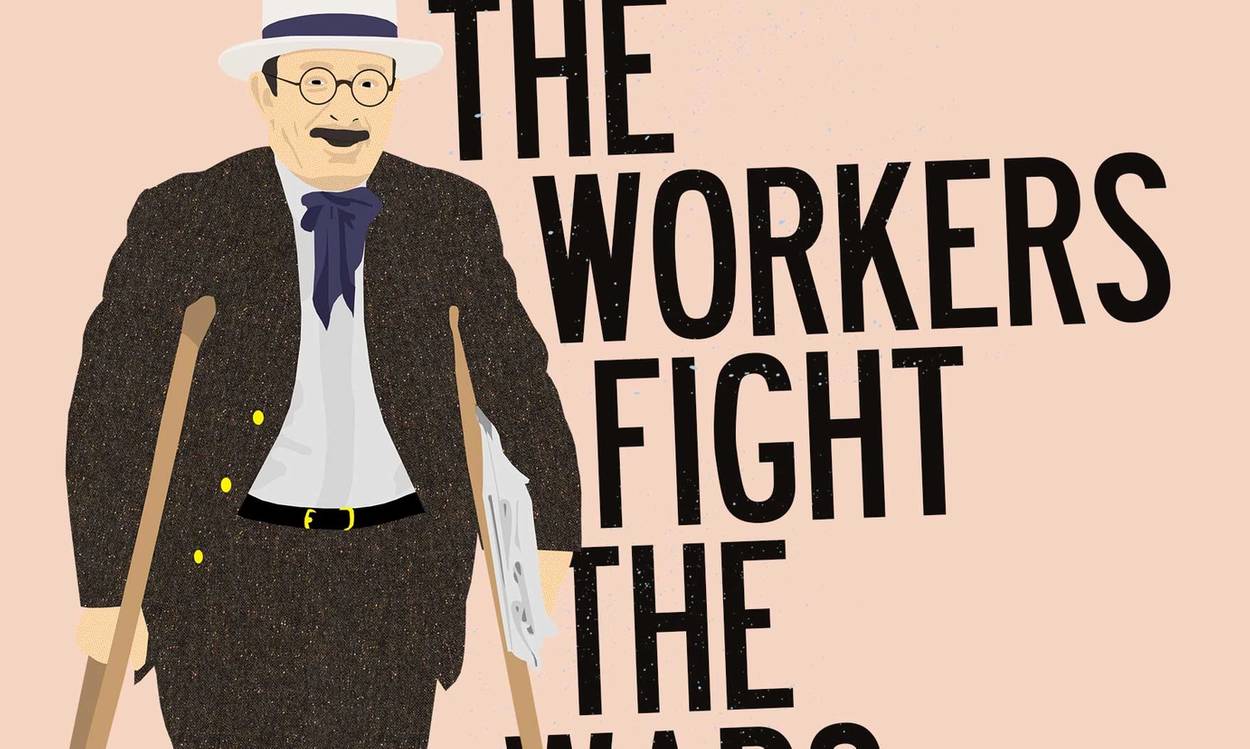
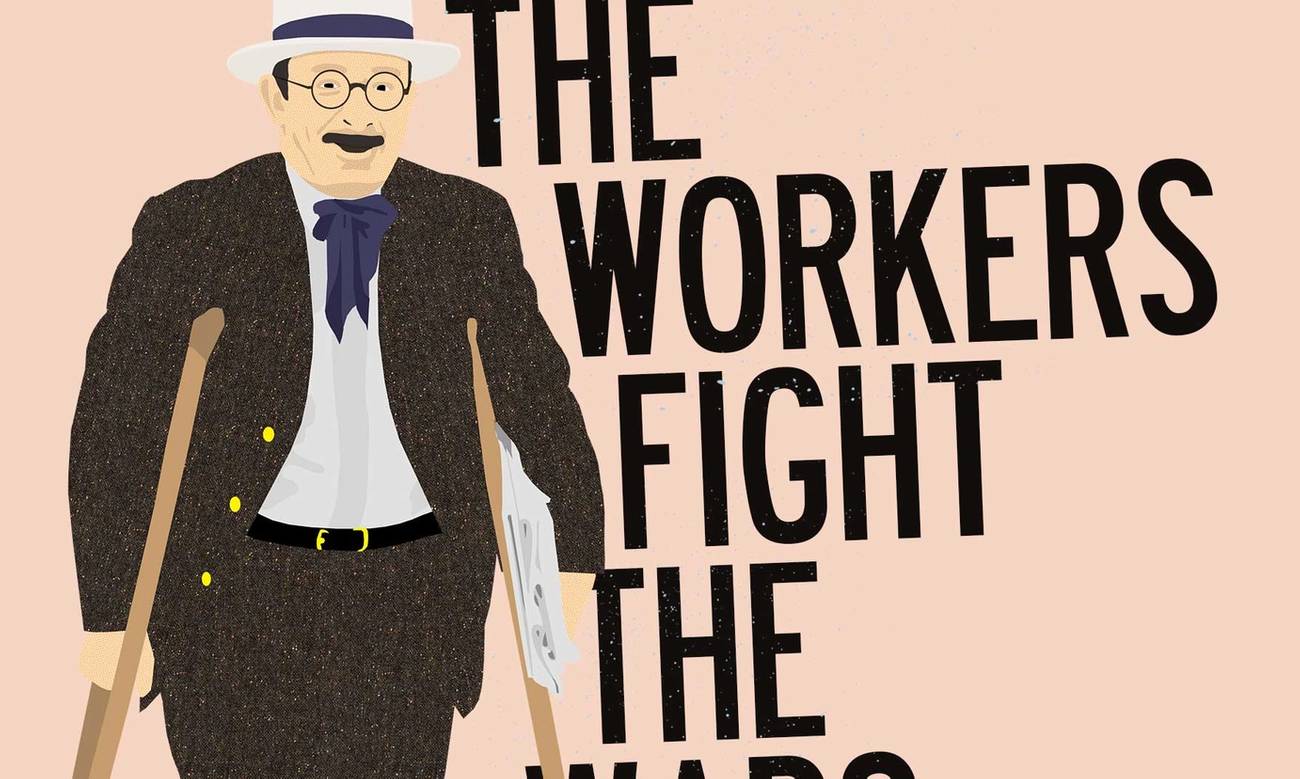


This is the first part of an extended history of the anarchists and the Jews. Read parts 2 and 3 here.
I.
The YIVO Institute on 16th Street in New York held a conference not long ago on the dusty theme of “Yiddish Anarchism: New Scholarship on a Forgotten Tradition,” and, whoa!—some 250 people filled the auditorium, and another 200 people followed the activities from another room, and another couple of thousand were said to be following online. A handful of the participants were scholarly historians, who delivered lectures on the revolutionary movement in Russia during czarist times of old, and on the Jewish emigration to the East End of London, where anarchist ideas took root, and the further emigration to the Lower East Side of New York and the American beyond, where the same ideas began to prosper.
Another handful of participants, sprinkled about the hall, were people with a sufficient claim on seniority to remember the last surviving veterans of those ancient anarchist adventures. And everyone else at YIVO’s event, the masses seated in the raked auditorium rows or standing at the aisle mics or milling about in the corridors, proved to be youngish and young, dressed in graduate-student drab or more stylishly, kink in the ink, and, either way, appeared to be visibly enthralled, as if each new revelation about Yiddish-speaking rebellions of times gone by bore on pressing matters of our own vexed and crisis-ridden English-speaking moment.
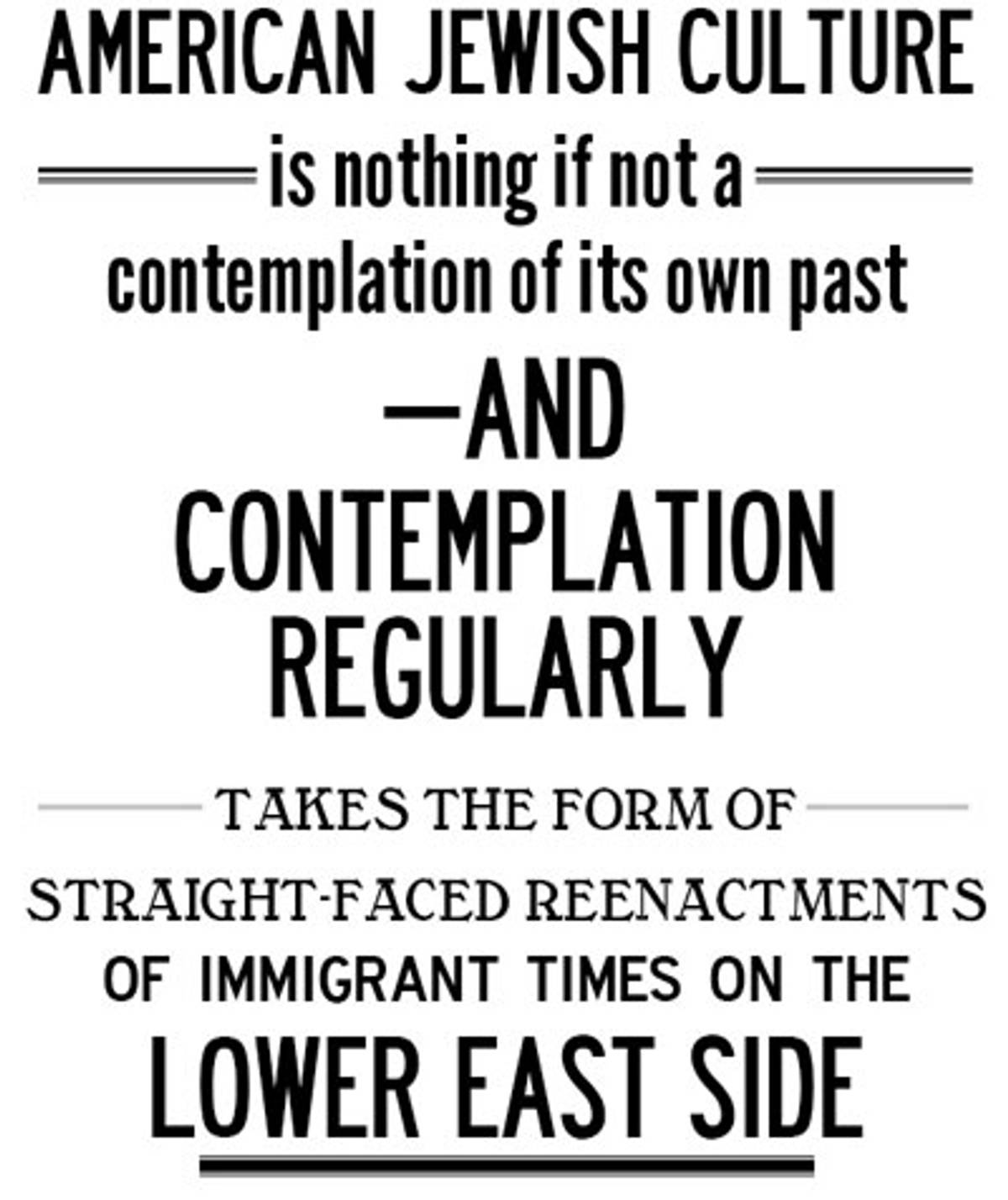
Those many people were more than a crowd, they were a subculture, and their existence hinted of larger rumblings among the young and the radical, Jewish and otherwise. A former editor of In geveb: A Journal of Yiddish Studies named Diana Clarke, currently enrolled at the University of Pittsburgh, delivered a lively presentation on the Yiddish-language revival and the complexities of what is called “post-vernacular Yiddish,” with related remarks on the double theme of poetry and anarchism. And, in the course of making this presentation, they (Diana Clarke prefer the plural pronoun) invoked still further expressions of the anarcho-subculture of our own moment in the zones of rock music and chicken farming, e.g., the anarchist punk band Koyt Far Dayn Fardakht and the upstate New York queer anarchist farm Linke Fligl, in sympathetic vibration with still vaster insurrectionary worlds of punkdom, queerness, leftism, and the utopias of discontent. To which people in the rows of seats gave a cheer (even if a woman got on line at the aisle mic to ask: What about the chickens?). Someone else described the anti-fascist demonstrations of our own era in the Pacific Northwest, attended by militants who carry placards in Yiddish, in order to show the flag, as it were, which was striking to consider.
Yes, the subculture had its oddities. And yet, in no respect were those particular oddities novelties—not in the world of the American Jews. American Jewish culture is nothing if not a contemplation of its own past; and contemplation regularly takes the form of straight-faced reenactments of immigrant times on the Lower East Side. There are Jewish delis that print 1890s street scenes on their menus, with Jews in bowler hats. There are Jewish summer camps that teach the little darlings to stand in front of a Statue of Liberty and pretend to speak Yiddish. It may be ridiculous—it is certainly funny—Yiddish anti-fascists of the Pacific Northwest, ha!—but is it foolish? I think it is normal. I confess, anyway, that now and then I have staged my own reenactments, and, although I am generally me, at moments I have preferred to be my grandfather, long-gone stalwart of the apparel-workers’ cause. Gravely I inspect the pickles at Katz’s. It is a way of allowing my thoughts to wander in fertile confusion over what is today and what was long before my time. Doesn’t everybody do that?
II.
The Golden Age of Jewish anarchism in America got started in the mid-1880s and lasted a couple of decades, and then gave way to an oddly prolonged and creative second act. And if those early decades have become a little dim in memory—if anarchism’s place in American Jewish life has become, in fact, a “forgotten tradition,” as the YIVO conference proclaimed—if the names of leaders and organizations and newspapers and even the names of doctrines have become unrecognizable to us, or nearly so, in our own era—it is because the 1880s were long ago. But mostly it is because, in those years, the mass Jewish immigration from Russia to London to New York and Baltimore and Boston was just getting underway, and the people stepping off the boat had not yet figured out how to present themselves in ways that might seem even halfway familiar to us today.
They were, of course, wretchedly poor—they were the “wretched refuse,” from the Emma Lazarus poem in 1883—even if, in a few cases, they came from reasonably prosperous families. And they did yearn to be free—yearned to escape the wave of zealotry against the Jews that had very suddenly begun to rise in the Russian empire, and its legal expressions, and its violent expressions, not to mention czarism itself. But they had not yet figured out how to describe their own place in the Jewish world, or how to picture a Jewish life in the America that was already theirs.
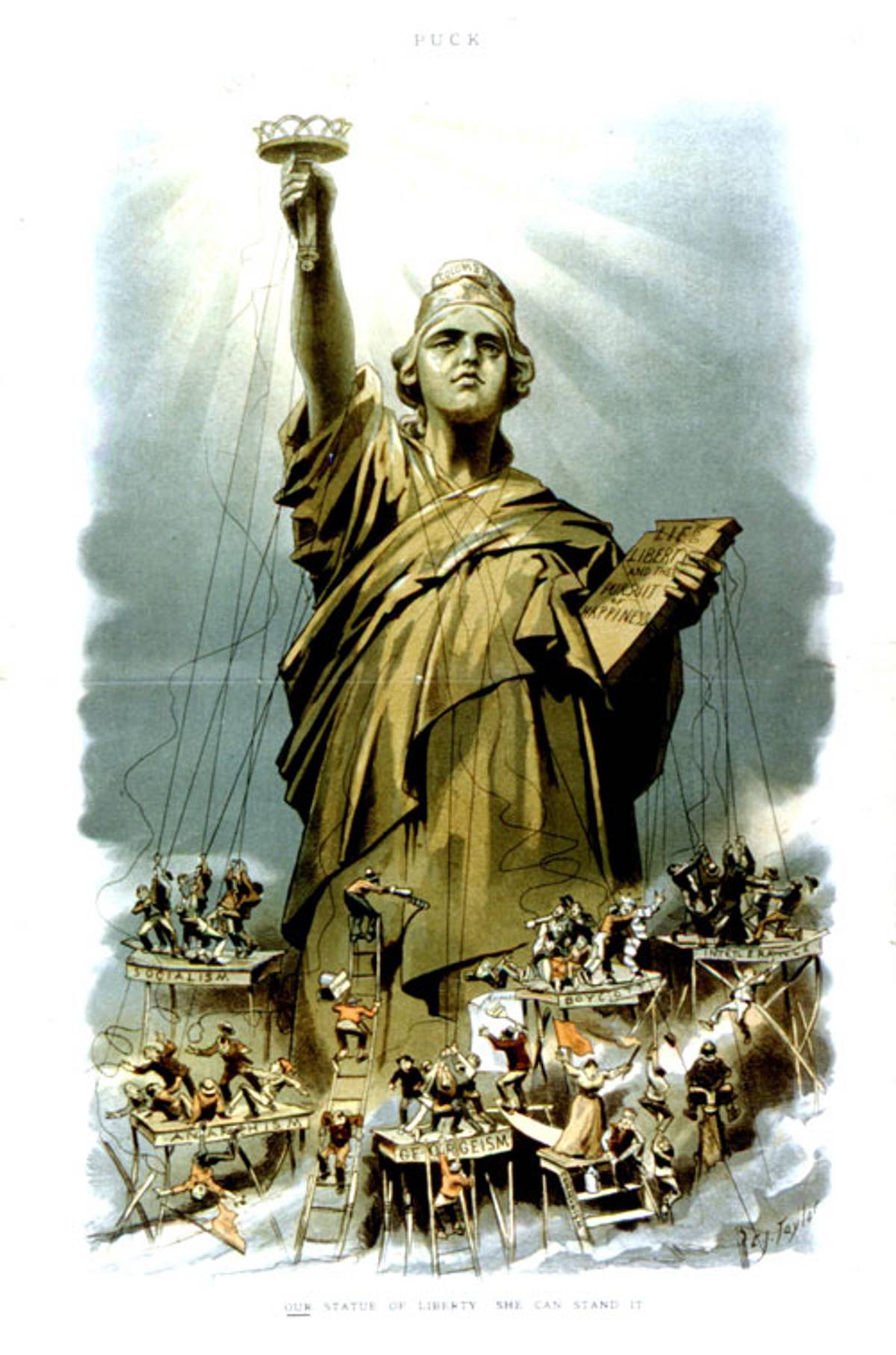
Some of the first people off the boat, the poorest of them, were pious, and now and then a distinguished rabbi arrived, and the pious Jews managed to build impressive synagogues here and there, which was an achievement. But the people who gave a tone to the early immigration do not appear to have taken much interest in that sort of thing, or perhaps no interest at all, or only a negative interest. And the secular tone tended to dominate and endure. The historian Tony Michels, the author of A Fire in Their Hearts: Jewish Socialists on the Lower East Side, tells us that, as late as 1916 (by which time the early immigration had swollen into something enormous), relatively few American Jews belonged to a synagogue, a mere 12%, he says—which can only mean that, in the 1880s and ’90s, at the very start, the percentage must have been minuscule.
Only, it was not yet obvious which language the secularism was going to speak. The poorest of the new arrivals spoke Yiddish. But the leading personalities—the notables—did not speak Yiddish, and did not think well of it, either, and appear to have been indifferent, for the moment, to arguments back in the Old Country on behalf of a new and improved Yiddish, elegant and literary. In their eyes, Yiddish, like thatched roofs, was something to escape. They preferred the languages of the educated class, which were Russian, or German, or both, with English as an aspiration for tomorrow. They loved those languages, they saw in them a civilization, and in the combination of language and civilization they saw an identity. They thought of themselves as Russians (of a certain ethnic stripe, to be sure), or sometimes as Germans (of the same stripe), with no reason to emphasize the stripe.
The home those people found in downtown New York was nestled within the genuinely massive immigration of those years, which was German, and the welcome they received was ambiguous. The New York trade unions discriminated against them, if only out of an insular desire to keep the good jobs within the family. But there was a countervailing friendliness. Back in Germany, the labor and socialist movements had begun to exhibit a lot of strength. And, in America, the German immigrants took up the new ideas, which ought to strike us as truly a forgotten tradition—remembered perhaps in an occasional novel by William Dean Howells or Frank Harris, but not in anything written by the German immigrants themselves. Along with the aggressive labor doctrines came an all-embracing spirit of tolerance, hostile to invidious and superstitious discriminations, and dedicated to socialism’s fundamental principle in those times, which was the idea about the universal working class and its historic destiny.
The newly arriving Russians of a certain stripe, and the Germans of the same stripe, saw an appeal in those ideas, and they responded by doing the obvious thing. They brushed aside the early discriminations against them, and they enlisted in the American labor movement, in one or another of its principal denominations, as of the 1880s—in the fusty and pre-industrial Knights of Labor, whose future was not looking good, but which had not yet expired; or in the trade unions and German-speaking political ranks of the Socialist Labor Party, whose leader, Daniel De Leon, happened to be a Jew (from the Dutch Caribbean), not that anyone cared, with hopelessly rigid ideas. Or they enlisted in the canny and newly hatched American Federation of Labor, whose leader, Samuel Gompers, likewise happened to be a Jew (from London, with a Dutch background), with marvelously flexible ideas. Or they enlisted in the labor movement’s fourth denomination, whose style, not at all canny or coolheaded, and with no Jews at all among the leaders, tended toward the histrionic and the overwrought. This was the anarchist faction—meaning, the anarchist wing of the broader socialist and labor movement.
The anarchists were a power within the national labor movement, mostly because they attracted a good many of the German immigrants, and because, in an age of violent capitalists, overwrought histrionics made a bit of sense, emotionally speaking. The anarchists dominated the Chicago unions. Their campaign for the eight-hour workday made them popular. They dominated the Chicago unions. Their martyrs—the Chicago anarchists, hanged in 1887—became the cause of the moment for almost everybody in the labor movement, radical or conservative. The Chicago martyrs became especially the cause of the newly arriving Jews—who, having just stepped off the boat, were horrified to discover that America’s champions of the eight-hour day were dangling from gibbets. A small and distinctly Jewish constellation of tiny trade unions began to emerge on the Lower East Side and a few other places, and anarchism became its “leading current”—which is a phrase I adopt from a very capable historian named Kenyon Zimmer, who was one of the organizers of the YIVO conference.
The leading current flowed through the center of Jewish immigrant community life, such as it was—a turbulent center, awash in polyglot public debates and meetings, learned disputations, lectures, union quarrels, and newsstand wars. And, in barely visible ways, the leading current began to redirect the immigrant chaos toward the only outcome, linguistically speaking, that made sense, which was an acceptance of Yiddish as the language of the Jewish labor movement, and therefore as the language of the larger immigration—Yiddish, even if the immigrant notables had to struggle to pick it up.
In 1890 a Yiddish newspaper called the Freie Arbeiter Stimme made its shaky appearance on the Lower East side—an anarchist labor journal whose very name invoked the last words of the most articulate of the Chicago martyrs, Albert Parsons, “Let the voice of the people be heard!”—which became the newspaper’s motto. The Freie Arbeiter Stimme right away expired, in token of the fragility of immigrant institutions. But the Russians of a certain stripe gave some thought to this, and they put together a labor organization called the Pioneers of Freedom, which was explicitly Jewish, a novel step. The Pioneers of Freedom arrived at the view that, from a proletarian perspective, a Yiddish press was logically indispensable. They replanted the newspaper, and it sprung back into life with sufficient vigor to became one of a handful of institutions from the earliest period of the mass immigration to survive during most of the next hundred years: a marvel of longevity that, all by itself, ought to tell us something about anarchism’s place in the history of the American Jews.
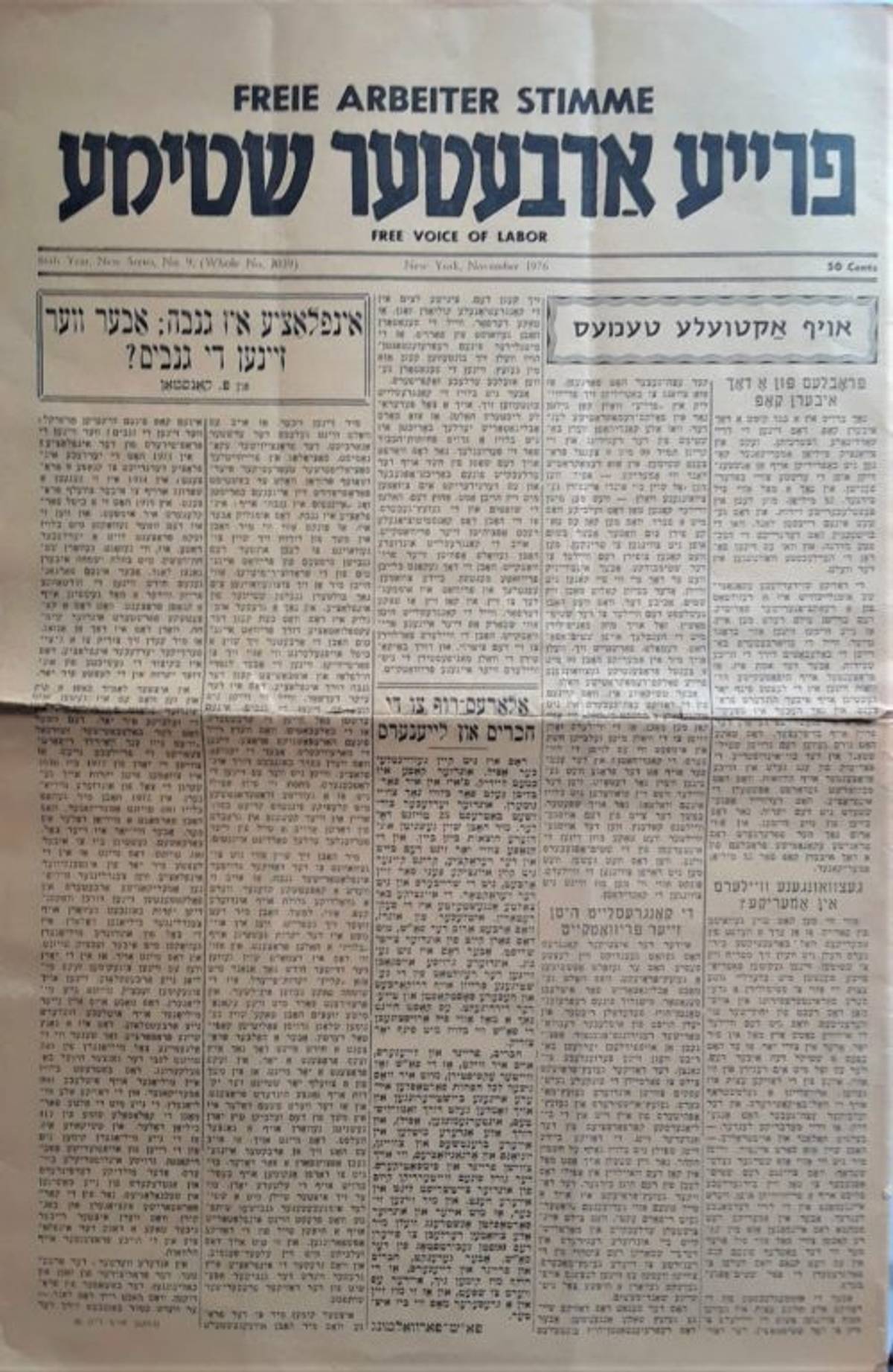
Maybe a few traces of those early days do linger in memory, if only because, among the Jewish immigrants, unlike the German immigrants, an English-language book-writing habit eventually took hold, and vivid accounts of the anarchist moment sometimes crept into the literature, and sometimes the literature proved to be enduring. There is even a masterpiece in this particular genre. It is Emma Goldman’s autobiography, Living My Life, from 1931, with page after page conjuring the still largely German Lower East Side of circa 1890 and its cafés and bars and the meetings and conspiracies and amorous complications, and the young Emma’s first impressions of her great companion, the ill-fated Alexander Berkman of Lithuania, linotypist at a wildly radical German labor anarchist newspaper—one of the earliest classics of the literature of a Jewish America that had not yet begun to think of itself as a Jewish America.
Or, if you want to peer more systematically into those vistas and events, you can do so in the pages of a series of scholarly books, which do a good job of conjuring the energy—a distinguished series, scrupulously and polylingually researched, and nicely written, too, which add up to a respectable literature of their own, in a scholarly mode: to wit, Paul Avrich and his daughter Karen Avrich’s very fine biography of Berkman and Goldman, Sasha and Emma, together with Paul Avrich’s Anarchist Portraits and Anarchist Voices and other studies; together with Tony Michels’ Fire in Their Hearts and Kenyon Zimmer’s book, Immigrants Against the State: Yiddish and Italian Anarchism in America. And there are studies of the German immigration by Tom Goyens, who was likewise at YIVO. And other books—all of which, taken together, capture something of anarchism’s achievement, too, and not just the energy.
For the anarchists—the Jewish anarchists, principally the people around the Freie Arbeiter Stimme—did achieve something. They proposed the idea of a workers’ movement to their fellow immigrants. Sometimes they made a hash of their own idea and talked themselves into sneering at the tiny new trade unions (on the grounds that unionism was a tepid and contemptible thing, and the horrors of industrial capitalism were more than unions could handle, so why not hold out for a spontaneous proletarian revolution, which was somehow in the air?). But the practicality of unionism returned to mind. And they conferred on their idea an imaginative grandeur.
They pictured the workers’ movement as a cultural force, and not just an economic one. It was the anarchists, Michels tells us, who founded the original workers’ education society in the Jewish labor movement. They stood for books and theater, for science, for the kinds of ideas about gender and family relations that used to be known as “advanced,” together with their utopian vision of how, if only a decent revolution would take place, industry and commerce and the whole of society could properly be reorganized. Atheism, too—something beyond mere secularism—figured in their idea, openly and aggressively proclaimed in the outrageous Yom Kippur balls, which, beginning in 1889, proved to be genuinely popular, not just in New York (even if, as the historians tell us, the subversive thrills of atheist transgression faded after a while, when the news arrived of still more pogroms in Kishinev and Russia, and a solicitude for the pious Jewish victims began to make the anti-religious railings and jeers seem in poor taste).
They translated into Yiddish the essays of Peter Kropotkin and the other grand theoreticians of the libertarian socialist idea, which gave a cosmopolitan hue to what might otherwise have seemed a parochial or sectarian affair. And—this was their achievement—they succeeded in imposing a spirit of those ideas on a visible portion of the mass immigration: not every twist of the doctrine, but the spirit as a whole, such that Jewish trade unionism on the Lower East Side and in similar neighborhoods came to reflect the basic concepts, not just as a passing fad. Here, then, was a beginning of American Jewish culture—not the only beginning, and not a fully worked out beginning, but, even so, a starting point for a substantial number of people.
And then, having done all that, the anarchists discovered that, with yet another series of pogroms going on in Russia, this time in the aftermath of the Revolution of 1905, still more terrified people were disembarking at the wharves. And the Jewish neighborhoods were swelling beyond anything imagined back in the 1880s and ’90s, and the garment factories were likewise swelling, and so were the needle-trades unions and their labor uprisings, and so were anarchism’s rivals on the left and in the unions.
The rivals were people who had gotten their start in the antique and German-speaking Socialist Labor Party, but had wisely exited its ranks in favor of a more attractive home in a newer, broader, more democratic, less dogmatic political party. This was Eugene V. Debs’ party, the Socialist Party of America, which had about it an air of success. The new wave of immigrants included more than a few people with backgrounds in the Russian revolutionary cause and especially in the Yiddish-speaking wing of the Social Democratic movement, which was the General Jewish Labor Bund. And the Bundists likewise made their way into the Socialist Party of America, where they turned out to have an entrepreneurial gift. Marxism, in their version of it—the orthodox Marxism of Karl Kautsky in Germany, as adapted to Jewish circumstances—gave those people a better purchase on economics and social science than anarchism and its grandest theoreticians could offer. And, on the Lower East Side and in parts of Brooklyn and a few other immigrant corners, the up-to-date and scientific-minded Jewish Socialists shouldered aside the antique anarchists in the unions. The Socialist newspaper, the daily Forverts, shouldered aside its older sister, the anarchist Freie Arbeiter Stimme, on the newsstands. And the center of downtown Jewish political energy life passed into Socialist hands, which was a good thing, mostly.
The Socialists knew what to do. It was the downtown Socialists who transformed the American Jewish workers’ movement and its trade unions and its newspaper into a power in the early and middle decades of the 20th century—the Socialists who brought a great many of the poorer and humbler immigrants and their children into the more-or-less modern era, and did a lot for the larger American labor movement, and for America as a whole, and did a lot for fraternal labor movements in other parts of the world, too, even if no one remembers this. The downtown Socialists even performed an occasional miracle for the American Jewish business class, if I may continue speaking of things that no one remembers—performed miracles by doing what the cutthroat manufacturers could never do for themselves, which was to impose regulations and order on the garment industry, with its sweatshops, gangsters, cockroach manufacturers, and ungovernable market.
III.
I have always found something appealing, though, in the anarchist inspiration from the early years, and something still more appealing in the inspiration as it evolved in later decades, when the anarchists were no longer the vanguard of the vanguard. It is not so much their proposed utopia—the grassroots self-government, the libertarian and communalized economy, and everything else that you can read about in Kropotkin’s tract, The Conquest of Bread, from 1892, the greatest of the anarchist books—but something deeper, which was assumed more than articulated. This was their idea of who was going to populate and animate the utopian institutions.
It was going to be an artisan worker—someone manually or technically skillful, with an independent streak, economically productive, inventive, altruistic, generous, intellectually curious, free-thinking, instinctively egalitarian, and scientifically minded. And the anarchists conceived of an attractive ideal personality for themselves, as well, the militants of the revolutionary cause, even before any new institutions could be brought into existence. This personality, the ideal anarchist, was someone who chooses to behave as if the new institutions already existed, and who treats everyone accordingly. Maybe a Russian flavor ran through the idea, hinting of the grandeurs of the old 19th-century Russian intelligentsia with its scruples and high-culture sophistication, and its faintly (or, in Kropotkin’s case, explicitly) aristocratic indifference to material pressures and enticements.
Sometimes the anarchists evinced a sympathetic interest in the adventures of the artistic avant-garde, which was unusual for a political movement. Anarchists in the decades around 1900 were sharper than Socialists in this regard, and less sentimental. Symbolist poetry, the avant-garde theater, the experiments in painting—the anarchists went for all of it. Or, at least, they did in Paris, which was the world center of anarchist thinking in those years. And sometimes they did in other places—in Buenos Aires, or in St. Petersburg in later years. A few rays from the faraway Parisian sun sometimes penetrated even into the dingy tenements of the Lower East Side and similar districts in the United States. The immigrant toilers may not have been in a position to work up a refined and sophisticated appreciation of the artistic outer reaches (which was a compassionate observation of Irving Howe’s in World of Our Fathers), and yet, sprinkled among them was a small class of educated people, transplanted from Russia or from other places (which was an autobiographical observation of Emma Goldman’s), who were keen on the avant-garde illuminations.
Poetry in the Freie Arbeiter Stimme is said to have been rather distinguished, from Mani Leib to Jacob Glatstein (though it is odd to read in Zimmer’s Immigrants Against the State that, in order to break into the paper, where the editor preferred women poets, the young Glatstein had to sign his poems “Clara Blum”). And the literature spoke of something more than literature. The Symbolist movement in poetry was a protest against the narrowness of mere science and logical calculations, in favor of a more-than-science that was going to vault upward into a spiritual upper ether, which the poets conjured as the capital-letter Ideal.
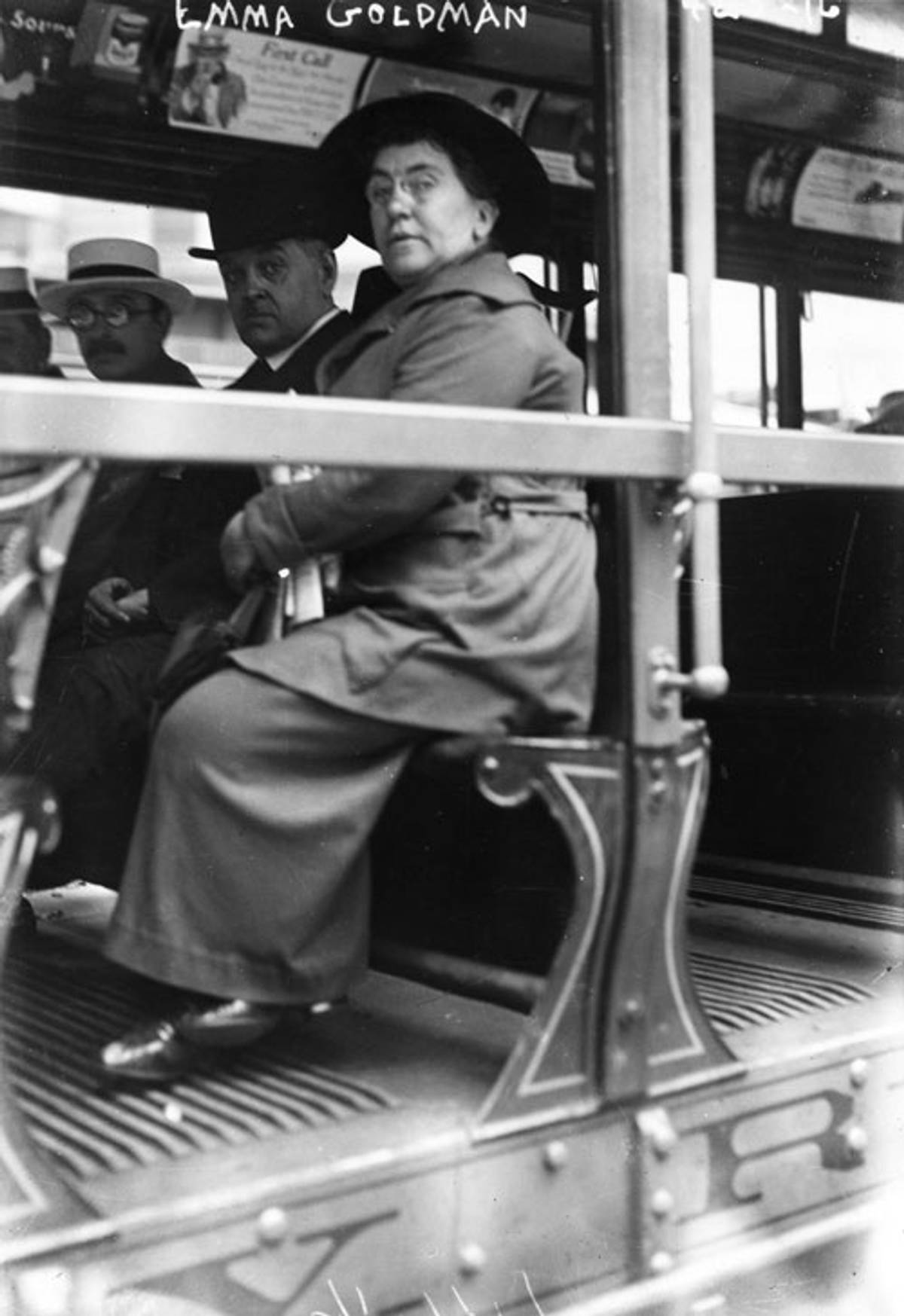
And the Ideal blossomed, as well, among the anarchists, some of them—blossomed in the writings of Emma Goldman and Alexander Berkman—blossomed as an inexpressible yearning that was poetic and political at the same time—blossomed into the belief that a life dedicated to the Ideal could be lived, if only as a continual and aesthetically shaped protest against the world, or perhaps as a morbid self-sacrifice. Those were religious notions, very nearly—notions about how, under the buoyant and not necessarily benign guidance of the ethereal Ideal, you should feel and think and what kinds of things you should do.
It was just that, however imaginative or moving those several ideas tended to be, the anarchists were never able to come up with plausible theories of how to get from here to there—from the oppressive society of the present to the beckoning Ideal of the future. They contributed to their trade unions and built a variety of rural colonies and cultural enterprises, and they trusted to time and the future to come up with larger possibilities. But reform legislation was beyond their ken, given their dogmatic insistence that government action is bad by definition. Nor could they campaign for better judges in the courts, given that courts seemed to them tyrannical by definition.
A variety of anarchists, not just the perpetually rebellious Goldman, were natural feminists, who appeared to have wandered into American life from the pages of N.G. Chernyshevsky’s St. Petersburg novels, where the women characters stroll about Nevsky Prospect and shock everyone with their modern and independent ways. But the anarchists could not get behind the campaign for women’s suffrage, given their view that voting, too, was bad by definition. Nor were the anarchists especially eager to look for areas in which workers and employers might collaborate for the greater good, given that, from a class-war perspective, the greater good required war to the death.
The anarchists weren’t bad on civil rights in the United States. Zimmer tells us that, in 1911, the Freie Arbeiter Stimme published an essay by W.E.B. Du Bois in Yiddish translation. But the civil-rights campaign was always a legal struggle, directed at judges and their rulings; and the anarchists were not legally inclined. So they inveighed against every possible social and cultural and economic yoke that hung across the neck of mankind, and meanwhile they fashioned a yoke of their own, consisting of their doctrines about the permissible and the impermissible in politics, and they slung it across their own necks, and slowly they lumbered forward.
Sometimes they sank into millenarian inebriations, and the inebriations took a sinister turn. Anarchism became an authentically popular movement in some of the Italian-immigrant neighborhoods during those same years, which Zimmer has described in his Immigrants Against the State. And sometimes the inebriates in those neighborhoods—the antiorganizzatori, who stood opposed to organizations as a whole (because any organization at all can only be a source of oppression)—drifted into a cult of violence, in the belief that a well-aimed bullet or a randomly placed bomb might detonate the revolutionary event.
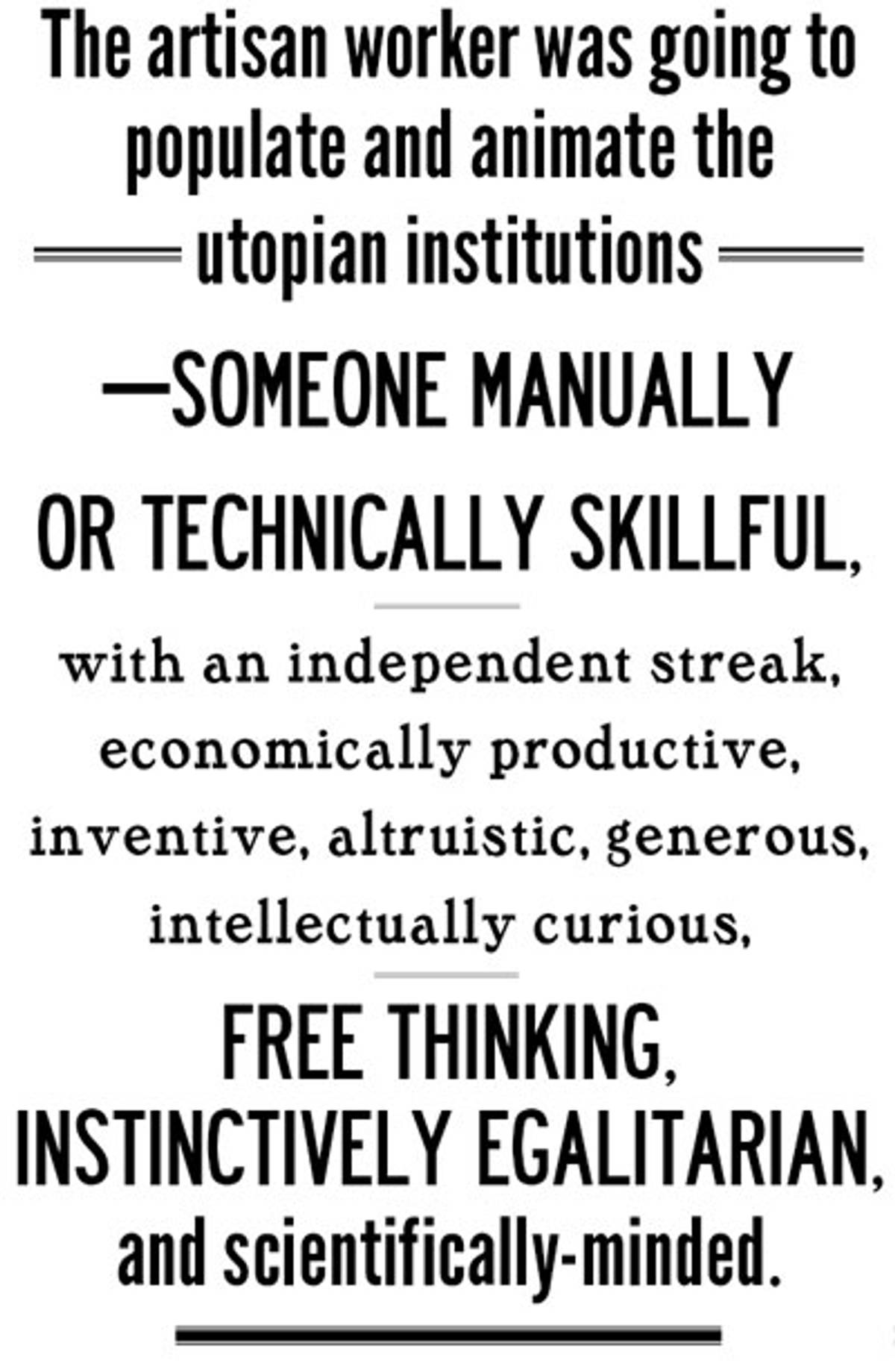
Or, even if violence turned out to be less than politically useful, there was a chilling belief that violent acts might serve an aesthetic or artistic purpose. Ideas of that sort made life in Paterson, New Jersey, hell in the years around 1900. The greedy mill owners were heartless, and the aesthetic anarchists, murderous. A few dozen random passers-by around the country were killed. Someone from Paterson returned to Italy and assassinated King Umberto I in 1900, and the assassination aroused an applause in various branches of the anarchist movement in America and around the world, which led to the copy-cat assassination of President William McKinley, in 1901. It was one pointless murder after another, celebrated sometimes with a gush of florid and ghoulish apologetics from people who had seceded from society and conventional morality: assassination as operatic performance, chiefly in Italian.
And, with those winds blowing about, a handful of Jewish anarchists, too, drifted in the aesthetic direction. There was Alexander Berkman (a curious case, whose attempt to assassinate Henry Clay Frick, the steel-industry tyrant, in 1892, led to 14 years in prison) and his circle, plus an occasional other person, and now and then someone who got caught up in the sinister glamour of the Italian antiorganizzatori. Still, the Jewish anarchists tended to be immune to the allure of violence. In Russia, the revolutionary movement had its armed wings, and some of the militants were Jewish, who fought in 1905; and, in America, someone was always raising funds for the Russian comrades.
But this may only have made it easier for the Jewish anarchists in America to draw a lucid distinction between czarist conditions and even the worst of American conditions. The Freie Arbeiter Stimme was coy about terrorist action in the early 1890s, and not averse to printing defiant speeches by European terrorists. But the editors and the mass of their readers eventually arrived at a resolute decision not to be at war with civilization, or society, or morality, or organizations. They did not wish to secede from society, they wished to join. And it has to be said that society—the Yiddish-speaking corners of American society, that is, which eventually amounted to a public of several million people—did not reject them, even in the years when the anarchists were no longer at the forefront of the Jewish labor movement.
Zimmer tells us that, by 1910, the circulation of the Freie Arbeiter Stimme had reached 15,000 to 20,000 a week, which wasn’t bad, when you figure that a typical copy might have passed from one set of hands to another. That was a third of the circulation of the daily Forverts in those days. By 1914, circulation was up to 30,000, which, according to Zimmer, was more than double the size of the combined memberships of all the Zionist organizations of America, in clear demonstration that labor anarchism was still a going concern; and Zionism, not yet. And the Jewish anarchists prospered outside of the Yiddish-speaking zone. Emma Goldman presented herself to the world in English as a bohemian voice for the artists and social reformers, and, on that basis, she ran her cultural center in East Harlem and went on lecture tours around the country.
Berkman, too, found a general American public, once he had gotten out of jail. He composed his Prison Memoirs of an Anarchist, in 1912, in English, and the book enjoyed a degree of mainstream success. He published a labor magazine that was insanely called The Blast, as if in weekly testimony to the depth and authenticity of America’s forbearing commitment to free speech, and people do seem to have read it. He was a charismatic man. He led crowds of protesters on marches through the streets. He and Goldman both were anything but shunned or marginal—though, of course, they did have their enemies, especially in the federal government, which eventually concluded that, in regard to free speech, enough was enough. The two of them were jailed for their agitations against American participation in the First World War. But there was worse for the anarchists.
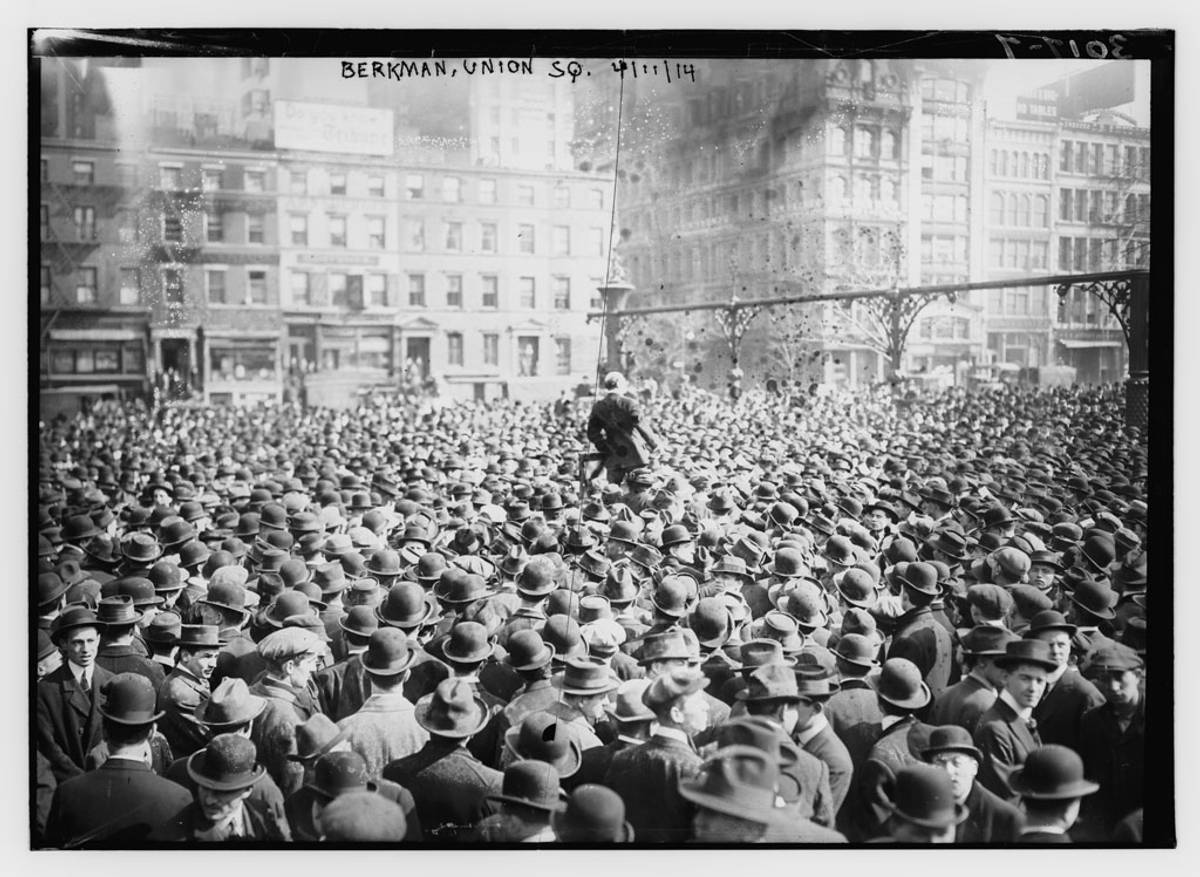
The ultimate catastrophe was the revolution—not the proposed revolution, but the revolution for real—that broke out in the Old Country in 1917. Lenin and the Bolsheviks announced a new phase of world history, which was plainly not going to have much room for anarchists and their theories. The new phase of history got underway. A gloom of defeat and irrelevance descended over the anarchist cause. And yet—this is striking—the Jewish anarchists in America over the next years, the Yiddish-speakers especially with their newspaper and their trade union factions, managed to survive and even to retain a bit of their public, and they did this by demonstrating that something in their original inspiration was more insightful than even the most sympathetic of their critics may have noticed.
IV.
The Russian Revolution ended up producing a substantial American ex-pat community in Moscow and other places in Russia, and the reason for this was large and obvious. New York in the 1910s was the third largest Russian city, after Moscow and St. Petersburg. Some 28% of New York City’s population, or 1.4 million people, in Tony Michels’ figure, were Jewish, which meant chiefly the immigrants from the Russian empire and their children—on top of which was a massive additional population from the other ethnic groups of the Russian empire, beginning with the Russian Russians. Some of those immigrants were vehemently left wing, who felt the temptation to return to the Old Country and participate in the Revolution. More than 20,000 people made such a choice, according to Kenyon Zimmer’s figures, in the early years after the overthrow of the czar. The Union of Russian Workers of the United States and Canada had some 15,000 members in 1919, ethnic Russians and Jews alike, largely with anarchist orientations, and a huge percentage of them made the decision to return.
The entire staff of a Russian-language anarcho-syndicalist newspaper on the Lower East Side made its way to Russia, and brought along their printing press. The Woodrow Wilson administration deported an additional couple hundred people, among whom were Goldman and Berkman, the best-known anarchists of all—world figures, both of them, by that time (with Goldman, who loved America, sorry to be deported, even if she was in jail; and Berkman, who despised America, glad to go). And then came further deportations.
The ex-pat community that arose in Russia was a bit unusual, then. It was a community of Americanized Russians, Jewish and non-Jewish, who, in returning to the Old Country, willingly or otherwise, did not lose their American characteristics, and indeed were proud of the characteristics, in the belief that a can-do spirit in the American style was exactly what Russia’s Revolution required. And they plunged into revolutionary work. Among the anarchists, some of the New York and Chicago Jews enlisted in Nestor Makhno’s peasant anarchist insurgency in the Ukraine, which went to war against the counterrevolutionary army and, at the same time, tried to coexist with the Bolsheviks. Other people—the so-called “Soviet anarchists”—clung to their identity as anarchists, and, in spite of the pesky little philosophical contradictions, which were enormous, took to collaborating actively with the Bolsheviks.
Some of the ex-pat anarchists abandoned their anarchist loyalties entirely and enlisted in the Bolshevik party, which is to say, the new Communist Party of Russia. And all of this—the different levels of anarchist collaboration with the Bolsheviks—made obvious sense. The danger to the Revolution in its early years from the extreme right in Russia and the old czarists was altogether terrifying. In southern Russia and the Ukraine, the pogromists launched yet another wave of massacres of the Jews, beyond anything seen in the previous decades. And Lenin and the Bolsheviks and their large and capable Red Army were on the right side of those struggles, which meant there was really no alternative but to lend them a support of one kind or another, and hope for the best.
The Red Army put down the Whites and brought the pogroms to an end. In other respects, though, the developments in Russia during those very early years of the Revolution were less than encouraging, from the anarchist standpoint. The ex-pat anarchists began to notice that Bolshevism’s dictatorship did not have the look of a temporary or emergency arrangement. Nor did it have the look of something cautious or restrained or respectful of persons and privacy. It had a look of corruption and inefficiency. It flaunted its dishonesty. It was systematically and even casually murderous, as if no one cared who was shot. And the ex-pats began to question their own judgment, began to wonder, to think skeptical thoughts, to argue amongst themselves—which we know because they produced a literature of their own experiences.
The most widely read of those writings was Goldman’s My Disillusionment in Russia, from 1923, an historic book because of how early and prescient was her condemnation of the Bolsheviks, followed by My Further Disillusionment in Russia (these were not her own chosen titles), all of which she reprised in her autobiography a few years later. Berkman produced a pamphlet or two, which were even earlier, followed by The Bolshevik Myth, in 1925, which was, I think, the most brilliantly written of the American ex-pat books, with extraordinary and horrifying pages devoted to the pogroms in the Ukraine and the sufferings of the Jews.
Still another contribution to the ex-pat literature was translated from the Yiddish into English by Ruth Murphy only just recently, in 2016, and was published in Mexico by the Centro Israelita de México. This is The J. Abrams Book: The Life and Work of an Exceptional Personality, by a follower of Berkman’s named Jacob Abrams, originally from the Ukraine, and later on from East Harlem in New York. Abrams is famous in the annals of civil-liberties law because of a Supreme Court case of 1919, United States v. Abrams et al., in which, although the court upheld the conviction of Abrams and his anarchist circle (for having committed the crime of tossing leaflets in English and Yiddish down to the street in New York, calling on the workers to rise up in revolution), Oliver Wendell Holmes Jr. wrote a stirring dissent in favor of free speech.
But Abrams, too, had his say. It is his book, which is a fragmentary autobiography. The book recounts episodes of his Ukrainian childhood in czarist times and his entrance into the revolutionary movement, skips over his period in New York and a couple of years in prison (in the same jail as Eugene Debs), and recounts his return to Russia, courtesy of still another deportation by the Wilson administration. And Abrams recounts his experiences and evolution as a loyal, reliable, and increasingly troubled “Soviet anarchist.”
Many a remarkable Russian theme floats into view: the New York ex-pat scene in the crowded apartments of Moscow in the early and middle 1920s, which would have been a glamorous scene, except that everybody was living in terror of the Bolsheviks; the flimsiness of the American can-do spirit, in the face of the Bolshevik bureaucracy; some extraordinary information about the execution of the Romanovs, gleaned at a dinner in Moscow, which makes a sensational story; a heartbreaking interview with Big Bill Haywood of the Wobblies, or Industrial Workers of the World, in his Moscow exile, who was also living in fear; scenes of the Ukrainian Jews, who went from cringing in abject terror at the Whites to cringing in tight-lipped fear at the Reds; and finally Abrams’ reluctant and much-delayed recognition that, under the Bolsheviks, things were getting scary, and he had better get out while he could—he and his faithful and appealing companion, Mary Domsky, who had managed to survive the Triangle Shirtwaist fire in New York, and who spent the next few decades accompanying Jacob from one martyrdom and exile to another.
The two of them made their way to Berlin and ultimately to Mexico and its Jewish émigré world—which is why The J. Abrams Book: The Life and Work of an Exceptional Personality has been published in its English translation by the Mexican Jews. And, in all of this, in Abrams’ pages, just as in the books by Goldman and Berkman, we see, stage by stage, what the ex-pat anarchists in Russia were able to observe. The anarchists observed that Lenin and the Bolshevik leaders had made a decision to carry their dictatorship to another level, and had decided to dispense with their anarchist allies, and to dispense with all of the other left-wing parties in Russia, as well. The anarchists observed that Lenin and the Bolsheviks had decided to liquidate those parties altogether, in the interest of creating a full and comprehensive one-party state. And gradually the anarchists came to understand what that was going to mean.
Zimmer in his Immigrants Against the State cites the leader of an anarchist prisoners’ aid organization named Boris Yelensky, of Chicago, an occasional contributor to the Freie Arbeiter Stimme, who arrived at the conclusion that, of the immigrant anarchists who returned from America to Russia, 90 percent were killed. Nor was it different, in the long run, among the other revolutionary Russian parties, the Social Democratic Mensheviks and Bundists, the Left Zionists, and sundry others. Liquidation was the Bolshevik policy. In the same spirit, Lenin and the Bolsheviks began to put mass famines to political use. Here, in the several years after 1917, was the birth of modern totalitarianism: the massacre of entire segments of a population, not as a hot-headed byproduct of wartime hysteria, nor as a mad reversion to barbarism, nor as the unintended consequence of a clash of incompatible cultures, but as a matter of cool-headed policy: extermination as social reform.
And so, the anarchists—the Jewish anarchists in America, and their comrades—ended up making two great contributions, not just one, to the world around them. They proposed a vision of society based on wholesome work in an artisanal style, which reflected the doctrine they had imbibed from Kropotkin and the other anarchist theoreticians: founding ideas of the Jewish labor movement. And, some 30 years later, they showed that, by drawing on their original vision, they were capable of identifying the immense and terrible task of the 20th century, which was to put up a struggle against the totalitarian movements. In a second essay, I will recount how the anarchists, in the years of their defeat, went on to conduct that particular struggle and what were their contributions, which seem to me more than minor—seem to me fairly glorious.
This is the first part of an extended history of the anarchists and the Jews.
Paul Berman is Tablet’s critic-at-large. He is the author of A Tale of Two Utopias, Terror and Liberalism, Power and the Idealists, and The Flight of the Intellectuals.